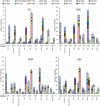Antimicrobial Susceptibilities of Clostridium difficile Isolates from 12 Asia-Pacific Countries in 2014 and 2015
- PMID: 32393487
- PMCID: PMC7318032
- DOI: 10.1128/AAC.00296-20
Antimicrobial Susceptibilities of Clostridium difficile Isolates from 12 Asia-Pacific Countries in 2014 and 2015
Abstract
Clostridium (Clostridioides) difficile causes toxin-mediated diarrhea and pseudomembranous colitis, primarily among hospital inpatients. Outbreaks of C. difficile infection (CDI) have been caused by strains with acquired antimicrobial resistance, particularly fluoroquinolone resistance, including C. difficile ribotype (RT) 027 in North America and Europe and RT 017, the most common strain in Asia. Despite being the most common cause of hospital-acquired infection in high-income countries, and frequent misuse of antimicrobials in Asia, little is known about CDI in the Asia-Pacific region. We aimed to determine the antimicrobial susceptibility profiles of a collection of C. difficile isolates from the region. C. difficile isolates (n = 414) from a 2014 study of 13 Asia-Pacific countries were tested for susceptibility to moxifloxacin, amoxicillin-clavulanate, erythromycin, clindamycin, rifaximin, metronidazole, vancomycin, and fidaxomicin according to the Clinical and Laboratory Standards Institute's agar dilution method. All isolates were susceptible to metronidazole, vancomycin, amoxicillin-clavulanate, and fidaxomicin. Moxifloxacin resistance was detected in all countries except Australia, all RT 369 and QX 239 strains, and 92.7% of RT 018 and 70.6% of RT 017 strains. All C. difficile RT 012, 369, and QX 239 strains were also resistant to erythromycin and clindamycin. Rifaximin resistance was common in RT 017 strains only (63.2%) and was not detected in Australian, Japanese, or Singaporean isolates. In conclusion, antimicrobial susceptibility of C. difficile varied by strain type and by country. Multiresistance was common in emerging RTs 369 and QX 239 and the most common strain in Asia, RT 017. Ongoing surveillance is clearly warranted.
Keywords: Clostridium difficile; epidemiology.
Copyright © 2020 American Society for Microbiology.
Figures

Similar articles
-
Evaluation of the antimicrobial activity of ridinilazole and six comparators against Chinese, Japanese and South Korean strains of Clostridioides difficile.J Antimicrob Chemother. 2021 Mar 12;76(4):967-972. doi: 10.1093/jac/dkaa522. J Antimicrob Chemother. 2021. PMID: 33351917 Free PMC article.
-
Clostridioides (Clostridium) difficile in adults with diarrhoea in Vietnam.Anaerobe. 2023 Jun;81:102741. doi: 10.1016/j.anaerobe.2023.102741. Epub 2023 May 25. Anaerobe. 2023. PMID: 37244476
-
Antimicrobial resistance surveillance of Clostridioides difficile in Australia, 2015-18.J Antimicrob Chemother. 2021 Jun 18;76(7):1815-1821. doi: 10.1093/jac/dkab099. J Antimicrob Chemother. 2021. PMID: 33895826
-
Antimicrobial resistance in Clostridium difficile ribotype 017.Expert Rev Anti Infect Ther. 2020 Jan;18(1):17-25. doi: 10.1080/14787210.2020.1701436. Epub 2019 Dec 6. Expert Rev Anti Infect Ther. 2020. PMID: 31800331 Review.
-
Antimicrobial resistance in Clostridioides (Clostridium) difficile derived from humans: a systematic review and meta-analysis.Antimicrob Resist Infect Control. 2020 Sep 25;9(1):158. doi: 10.1186/s13756-020-00815-5. Antimicrob Resist Infect Control. 2020. PMID: 32977835 Free PMC article.
Cited by
-
Penicillin Binding Protein Substitutions Cooccur with Fluoroquinolone Resistance in Epidemic Lineages of Multidrug-Resistant Clostridioides difficile.mBio. 2023 Apr 25;14(2):e0024323. doi: 10.1128/mbio.00243-23. Epub 2023 Apr 5. mBio. 2023. PMID: 37017518 Free PMC article.
-
High Prevalence of Genetically Related Clostridium Difficile Strains at a Single Hemato-Oncology Ward Over 10 Years.Front Microbiol. 2020 Jul 20;11:1618. doi: 10.3389/fmicb.2020.01618. eCollection 2020. Front Microbiol. 2020. PMID: 32793147 Free PMC article.
-
Make It Less difficile: Understanding Genetic Evolution and Global Spread of Clostridioides difficile.Genes (Basel). 2022 Nov 24;13(12):2200. doi: 10.3390/genes13122200. Genes (Basel). 2022. PMID: 36553467 Free PMC article. Review.
-
Vitamin D3 and carbamazepine protect against Clostridioides difficile infection in mice by restoring macrophage lysosome acidification.Autophagy. 2022 Sep;18(9):2050-2067. doi: 10.1080/15548627.2021.2016004. Epub 2022 Jan 6. Autophagy. 2022. PMID: 34989311 Free PMC article.
-
A Survey on the Rationale Usage of Antimicrobial Agents in Small Animal Clinics and Farms in Trinidad and Jamaica.Antibiotics (Basel). 2022 Jul 1;11(7):885. doi: 10.3390/antibiotics11070885. Antibiotics (Basel). 2022. PMID: 35884139 Free PMC article.
References
-
- Miller BA, Chen LF, Sexton DJ, Anderson DJ. 2011. Comparison of the burdens of hospital-onset, healthcare facility-associated Clostridium difficile infection and of healthcare-associated infection due to methicillin-resistant Staphylococcus aureus in community hospitals. Infect Control Hosp Epidemiol 32:387–390. doi:10.1086/659156. - DOI - PubMed
-
- Centers for Disease Control and Prevention. 2019. Antibiotic resistance threats in the United States, 2019. US Department of Health and Human Services, Atlanta, GA.
MeSH terms
Substances
LinkOut - more resources
Full Text Sources
Molecular Biology Databases

